The Great Gatsby: Short Summary

The Great Gatsby ’s synopsis includes the main ideas of the story told by Nick Carraway. After moving to New York, he witnesses a tragic love story of Jay Gatsby and Daisy Buchanan. The plot spins around the wealth and complicated relationship between all the characters.
In this article prepared by our editorial team, you’ll find The Great Gatsby timeline and a short summary of the novel with pictures.
- 🖼️ Short Summary (with Pictures)
- 🗺️ Navigation

🎓 References
📈 the great gatsby timeline.
Below is a timeline of The Great Gatsby. It contains the key events connected to the novel’s plot.

🖼️ The Great Gatsby: Short Summary (with Pictures)
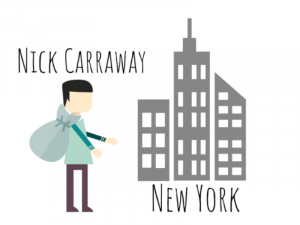
Nick Carraway, a young man from Minnesota and the story’s narrator, moves to New York City in 1922 . He rents a house in West Egg. His cousin, Daisy, lives in East Egg with her husband, Tom Buchanan.
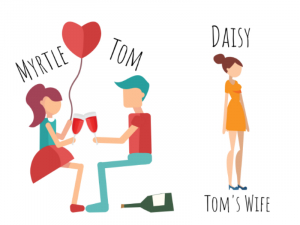
Tom is cheating on Daisy with Myrtle Wilson. The latter is quite a vulgar woman from a lower social class. She lives in the Valley of Ashes, an industrial dumping ground. Tom takes Nick with him to New York City and introduces him to Myrtle.
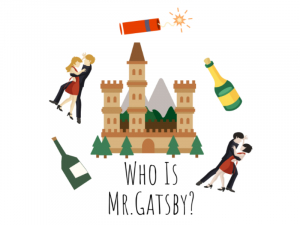
Everyone is fascinated by a certain Mr. Gatsby , a mysterious Nick’s neighbor who lives in a luxurious mansion and regularly throws epic parties. One day, Nick receives an invitation to one of Gatsby’s parties and gets acquainted with the host.
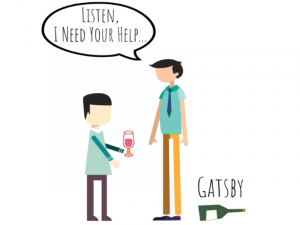
Gatsby seeks friendship with Nick. He talks to Jordan and tells her his story. It turns out that he and Daisy were in love with each other several years ago. Jay wants Nick to help them meet again.

Through Jordan, Gatsby asks Nick to arrange the couple’s reunion. The latter is ready to help. Daisy and Gatsby reestablish their connection . Meanwhile, Tom grows suspicious and starts investigating Gatsby’s affairs.

The true story of James Gatz is told here. He was born in a poor family and earned his fortune as a bootlegger. Tom and Daisy come to Gatsby’s party. Daisy doesn’t seem to enjoy it, while Tom wants to find out how Gatsby has earned his money.

One day, the whole company is gathered at the Plaza Hotel. Tom and Gatsby have a showdown over Daisy who is not ready to leave her husband. Daisy and Gatsby return to East Egg, and the car hits Myrtle. Gatsby wants to take the blame, though Daisy was driving.
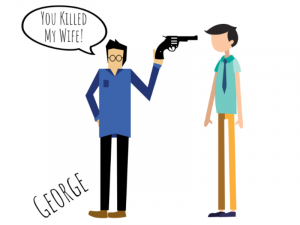
Nick sees Jay alive for the last time. Tom tells Myrtle’s husband, George Wilson, that Gatsby killed his wife, and tells where to find him. George makes his way to Gatsby’s mansion, shoots him, and then commits suicide.

Nick arranges Gatsby’s funeral. Only two people come, one of whom is Gatsby’s father. Daisy and Tom leave Long Island together, giving no forwarding address. Nick moves back to the Midwest.
- The Great Gatsby by F. Scott Fitzgerald – Free Ebook
- The Great Gatsby I Summary
- The Great Gatsby Research Papers – Academia.edu
- Share to Facebook
- Share to Twitter
- Share to LinkedIn
- Share to email
Study Guide Menu
- Short Summary
- Summary (Chapter 1)
- Summary (Chapter 2)
- Summary (Chapter 3)
- Summary (Chapter 4)
- Summary (Chapter 5)
- Summary (Chapter 6)
- Summary (Chapter 7)
- Summary (Chapter 8)
- Summary (Chapter 9)
- Symbolism & Style
- Quotes Explained
- Essay Topics
- Essay Samples
- Questions & Answers
- Chicago (A-D)
- Chicago (N-B)
IvyPanda. (2024, May 21). The Great Gatsby: Short Summary. https://ivypanda.com/lit/the-great-gatsby-study-guide/short-summary/
"The Great Gatsby: Short Summary." IvyPanda , 21 May 2024, ivypanda.com/lit/the-great-gatsby-study-guide/short-summary/.
IvyPanda . (2024) 'The Great Gatsby: Short Summary'. 21 May.
IvyPanda . 2024. "The Great Gatsby: Short Summary." May 21, 2024. https://ivypanda.com/lit/the-great-gatsby-study-guide/short-summary/.
1. IvyPanda . "The Great Gatsby: Short Summary." May 21, 2024. https://ivypanda.com/lit/the-great-gatsby-study-guide/short-summary/.
Bibliography
IvyPanda . "The Great Gatsby: Short Summary." May 21, 2024. https://ivypanda.com/lit/the-great-gatsby-study-guide/short-summary/.

A Summary and Analysis of F. Scott Fitzgerald’s The Great Gatsby
By Dr Oliver Tearle (Loughborough University)
The Great Gatsby is the quintessential Jazz Age novel, capturing a mood and a moment in American history in the 1920s, after the end of the First World War. Rather surprisingly, The Great Gatsby sold no more than 25,000 copies in F. Scott Fitzgerald’s lifetime. It has now sold over 25 million copies.
If Fitzgerald had stuck with one of the numerous working titles he considered for the novel, it might have been published as Trimalchio in West Egg (a nod to a comic novel from ancient Rome about a wealthy man who throws lavish parties), Under the Red, White and Blue , or even The High-Bouncing Lover (yes, really).
How did this novel come to be so widely acclaimed and studied, and what does it all mean? Before we proceed to an analysis of Fitzgerald’s novel, here’s a quick summary of the plot.
The Great Gatsby : plot summary
Nick Carraway, the narrator of the novel, is a young man who has come to New York to work on the stock exchange. He lives on the island of West Egg, where his neighbour is the wealthy Jay Gatsby, who owns a mansion.
One evening, Nick is dining with his neighbours from East Egg, Tom and Daisy Buchanan. Tom is having an affair, and goes to answer the phone at one point; Daisy follows him out of the room, and their fellow guest, a woman named Jordan Baker, explains to Nick about Tom’s mistress.
A short while after this, Nick is with Tom when Tom sets up a meeting with his mistress, Myrtle, the wife of a garage mechanic named Wilson. Nick attends a party with Tom and Myrtle; Tom hits his mistress when she mentions Daisy’s name.
In the summer, Gatsby throws a number of lavish parties at his mansion. He meets Jordan Baker again and the two are drawn to each other. Nobody seems to know the real Gatsby, or to be able to offer much reliable information about his identity. Who is he?
Gatsby befriends Nick and drives him to New York. Gatsby explains that he wants Nick to do him a favour: Jordan Baker tells him that Daisy was Gatsby’s first love and he is still in love with her: it’s the whole reason Gatsby moved to West Egg, so he could be near Daisy, even though she’s married to Tom. Gatsby wants Nick to invite both him and Daisy round for tea.
When they have tea together, Gatsby feels hopeful that he can recover his past life with Daisy before she was married. However, he knows that Daisy is unlikely to leave Tom for him. When she expresses a dislike for his noisy parties, he scales down his serving staff at his house and tones down the partying.
When they are all at lunch together, Tom realises that Daisy still loves Gatsby. Tom goads Gatsby as he realises he’s losing his mistress and, now, his wife. While staying together in a suite at the Plaza Hotel, Daisy tells Tom that she loves both men.
On their way back home, Gatsby’s car accidentally hits and kills Myrtle Wilson, Tom’s mistress, who has rushed out into the road after her husband found out about her affair. Tom finds her body and is distraught. Nick learns that Daisy, not Gatsby, was driving the car when Myrtle was killed.
Gatsby also tells Nick that he had built himself up from nothing: he was a poor man named James Gatz who made himself rich through the help of a corrupt millionaire named Dan Cody.
The next day, Nick finds Gatsby dead in his own swimming pool: Wilson, after his wife was killed by Gatsby’s car, turned up at Gatsby’s mansion to exact his revenge. Wilson’s body is nearby in the grass. The novel ends with Nick winding up Gatsby’s affairs and estate, before learning that Tom told Wilson where he could find Gatsby so he could take revenge.
The Great Gatsby : analysis
The Great Gatsby is the best-known novel of the Jazz Age, that period in American history that had its heyday in the 1920s. Parties, bootleg cocktails (it’s worth remembering that alcohol was illegal in the US at this time, under Prohibition between 1920 and 1933), and jazz music (of course) all characterised a time when Americans were gradually recovering from the First World War and the Spanish flu pandemic (1918-20).
One reason The Great Gatsby continues to invite close analysis is the clever way Fitzgerald casts his novel as neither out-and-out criticism of Jazz Age ‘values’ nor as an unequivocal endorsement of them. Gatsby’s parties may be a mere front, a way of coping with Daisy’s previous rejection of him and of trying to win her back, but Fitzgerald – and his sympathetic narrator, Nick Carraway – do not ridicule Gatsby’s behaviour as wholly shallow or vacuous.
Fitzgerald’s choice to have a first-person narrator, rather than a more detached and impersonal ‘omniscient’ third-person narrator, is also significant. Nick Carraway is closer to Gatsby than an impersonal narrator would be, yet the fact that Nick narrates Gatsby’s story, rather than Gatsby telling his own story, nevertheless provides Nick with some detachment, as well as a degree of innocence and ignorance over Gatsby’s identity and past.
Nick Carraway is both part of Gatsby’s world and yet also, at the same time, an observer from the side-lines, someone who is not rich and extravagant as many in Gatsby’s circle are, yet someone who is ushered into that world by an enthusiastic Jay Gatsby, who sees in Carraway a man in whom he can confide.
Nevertheless, Fitzgerald deftly sets the world of West Egg, with Gatsby’s mock-chateau and swimming pool, against the rather grittier and grimier reality for most Americans at the time. If Gatsby himself symbolises the American dream – he has made himself a success, absurdly wealthy with a huge house and a whole retinue of servants, having started out in poverty – then there are plenty of reminders in The Great Gatsby that ‘the American dream’ remains just that, a dream, for the majority of Americans:
About half way between West Egg and New York the motor-road hastily joins the railroad and runs beside it for a quarter of a mile, so as to shrink away from a certain desolate area of land. This is a valley of ashes – a fantastic farm where ashes grow like wheat into ridges and hills and grotesque gardens where ashes take the forms of houses and chimneys and rising smoke and finally, with a transcendent effort, of men who move dimly and already crumbling through the powdery air.
This is the grey, bleak, industrial reality for millions of Americans: not for them is the world of parties, quasi-enchanted gardens full of cocktails and exotic foods, hydroplanes, and expensive motorcars.
Yet the two worlds are destined to meet on a personal level: the Valley of Ashes (believed to be modelled on Corona dump in Queens, New York, and inspired by T. S. Eliot’s The Waste Land ) is where Wilson’s garage is located. The dual tragedy of Gatsby’s and Wilson’s deaths at the end of the novel symbolises the meeting of these two worlds.
The fact that Gatsby is innocent of the two crimes or sins which motivate Wilson – his wife’s adultery with Tom and Daisy’s killing of Myrtle with Gatsby’s car – hardly matters: it shows the subtle interconnectedness of these people’s lives, despite their socioeconomic differences.
What’s more, as Ian Ousby notes in his Introduction to Fifty American Novels (Reader’s Guides) , there is more than a touch of vulgarity about Gatsby’s lifestyle: his house is a poor imitation of a genuine French chateau, but he is no aristocrat; his car is ‘ridiculous’; and his very nickname, ‘the Great Gatsby’, makes him sound like a circus entertainer (perhaps a magician above all else, which is apt given the magical and enchanted way Carraway describes the atmosphere and detail at Gatsby’s parties).
And ultimately, Gatsby’s lavish lifestyle fails to deliver happiness to him, too: he doesn’t manage to win Daisy back to him, so at the same time Fitzgerald is not holding up Gatsby’s ‘success’ uncritically to us.
Is Gatsby black? Although he is known for having been played in film adaptations by Robert Redford and Leonardo DiCaprio, and the novel does not state that Gatsby is an African American, the scholar Carlyle V. Thompson has suggested that certain clues or codes in the novel strongly hint at Gatsby being a black American who has had to make his own way in the world, rising from a poor socio-economic background, and not fully accepted by other people in his social circle because of racial discrimination.
Whether we accept or reject this theory, it is an intriguing idea that, although Fitzgerald does not support this theory in the novel, that may have been deliberate: to conceal Gatsby’s blackness but, as it were, hide it in plain sight.
In the last analysis, The Great Gatsby sums up the Jazz Age, but through offering a tragedy, Fitzgerald shows that the American dream is founded on ashes – both the industrial dirt and toil of millions of Americans for whom the dream will never materialise, and the ashes of dead love affairs which Gatsby, for all of his quasi-magical properties, will never bring fully back to life.
Discover more from Interesting Literature
Subscribe to get the latest posts to your email.
Type your email…
10 thoughts on “A Summary and Analysis of F. Scott Fitzgerald’s The Great Gatsby”
I regret the several hours wasted in slogging through this low-prole distraction.
You might want to start with something like Dick and Jane.
One of my favorite novels. I have always loved this book. No matter how may times I read it, more is revealed.
The Great Gatsby is one of my favorite novels. Thank you for the detailed analysis! I can also add that Fitzgerald includes lots of symbols in the novel. To my mind, one of the most vivid symbols is a giant billboard with the face of Doctor TJ Eckleburg which is towering over the Valley of Ashes. These eyes are watching the dismal grey scene of poverty and decay. I guess the billboard symbolizes the eyes of God staring at the Americans and judging them. In case seomeone is interested in symbols in The Great Gatsby, there is a nice article about it. Here: https://custom-writing.org/blog/symbols-in-the-great-gatsby
While I could imagine and accept a modern film version of Gatsby as black, I really can’t espouse the notion that Fitzgerald had that in mind. If you know anything about American society in the 1920s, you’d know that you didn’t have to be black or of some other minority to be outside the winner’s circle. US society may still have tons of problems accepting that all people are created equal, but back then, they weren’t even thinking about blacks et al very much. They were quite happy to ostracize Italians, Irish, Catholics, etc, without batting an eye.
This is such a widely misunderstood book, by scholars as well as regulars.
Daisy was the victim of love. She would’ve married Jay while he was in the army. Also, Jay’s so-called symbolic “reaching” is nothing more than him trying to understand self love, to attain it, to unravel the “mystery! ” of it. But he never realizes he’s totally in love with himself, which is his biggest issue other than preying on Daisy’s real love.
And Nick ” Carraway” …. Care-a-way, care-a-way… What self-appointed moral man witnesses nakedly two married plotters sceam against a neighbor they like, or any person in serious need of legal, emotion aid, AND DOES NOTHING. Yeah, care a way, Nick, just not your way! And Come On!! who the hell doesn’t judge others….that’s the ENTIRE POINT OF EVERY BOOK AND LIFE.
WHAT preyed on Gatsby preys upon every person everywhere. Influences of life and choices we make because if them. Gatsby’s such an interesting, centralized , beloved character because he represents everyone’s apparent embracement of the childhood notion, ” we can have it all and make our own consequences, and if not, let’s see if I can manipulate time successfully. Gatsby’s us the full human demonstration of self love at all costs and quite deliberately finding a way disguise and masquerade and mutate and thus deny this very fact while simultaneously trying to make it MAGICAL AND MYSTICAL.
ARTISTS, from geniuses to so-called laypeople, are all simple people with very basic emotions. That’s where ALL starts. They are not Gods, nor do they desire misunderstanding. Frankly, they just wanna see if you have any common sense. Once you get passed that, all literature resembles EVERY aspect of life.
A terrific novel and not bad adaptation as a movie by DiCaprio, I thought! While some of the comments on here are a little excessive, there is much to be said for the symbolism in the book. I rather like the fact that ‘West Egg’ and ‘East Egg’ surely hints at questioning who is the ‘good egg’ and who is ‘the bad egg’. The place names are so unusual that this must be deliberate (‘bad egg’ has been around since at least 1855) and we’re left to wonder just what is good and bad here. No character comes out smelling of roses in this story, which – for me – makes the novel utterly compelling.
Well said, Ken. It’s the subtlety of the characterisation which makes it for me – I know a lot of critics and readers praise the prose style, but I think it’s the way Fitzgerald uses Carraway’s narration to reveal the multifaceted (and complex) nature of Gatsby, Daisy, Tom, and even himself that is so masterly. I’ve just finished analysing the opening paragraphs of the novel and will post that up soon!
- Pingback: A Short Analysis of the Opening Lines of The Great Gatsby – Interesting Literature
- Pingback: A Summary and Analysis of F. Scott Fitzgerald’s ‘The Bowl’ – Interesting Literature
Leave a Reply Cancel reply
Subscribe now to keep reading and get access to the full archive.
Continue reading

The Wonderful World of the Great Gatsby - Summary, Analysis, Symbolism

Francis Scott Fitzgerald is the American writer that managed to describe the richness and carelessness of the 1920s in the USA in bright colors. The author himself was the child of the golden period, known as the “Jazz Age”. While those eccentric and lavish times are gone now, readers can still enjoy the heritage of his books that bring about the spirit of freedom, joy, and selfishness. “The Great Gatsby” is the most well-known of his novels. It was written in 1925 – the time of Dry Law, gangster wars, impressive parties, and spectacular lifestyles.
The life path of the protagonist of this book, Jay Gatsby, slightly resembles Fitzgerald himself. In his writing career, Fitzgerald has seen everything – from admiration and acclaim for his first novel “This Side of Paradise” in 1920, to destructive indifference and cruel critique for a number of his other works. Similarly, for Jay Gatsby, the achievement of the American dream turned out to be a devastating life tragedy – his way towards the top of the societal ladder, despite the fame and wealth it brought him, led to disappointment and loss. After reading the book the reader is able to understand that what people want deep inside are not material goods, but emotional ones – sincere, reciprocal, and eternal love.
Order an Essay Now & Get These Features For Free :
But for now, let’s forget about the shadows and transport ourselves into the American life of the 1920s: imagine yourself being surrounded by beautiful women, endless joy, sweet jazz music, people having fun, and the waves breaking on the shore next to the lavish mansion of the famous Jay Gatsby, the king of all party hosts.
Main Characters of the Book
The book is way more complicated than relationships between two persons — protagonist Jay Gatsby and his beloved Daisy Buchanan.
Who is Jay Gatsby? Is he a mystery, a fraud, a murderer, a rich man, or a poor man? He is all of those things to some extent, and at the same time he is none of those things. This man represents the collective image of a society where everybody can pick traits that they can relate to. Gatsby is a romantic man, a dreamer who enjoys beauty and kindness. He lives with the fantasy of being together with his beloved, Daisy. But at the same time, he is the product of his consumerist society; he defines his worth by the tribute other people pay to him.
Fitzgerald devotes the most attention to the first aspect of Jay’s personality – his romantic side. He spends a lot of time looking for past ideals and dreams, which in reality turn out to be lost and phony. Daisy is the dream, but also is the death of Gatsby. The fact that his image of her doesn’t hold true portrays the key message of the book – a civilization whose morals can be manipulated by the desire for material goods cannot be humane, nor happy.
Throughout the whole book, Gatsby’s image remains a bit blurry and undefined, partly because his story is told through the eyes of another person – Nick Carraway. The two opposite aspects of his personality that live side by side in Gatsby’s character are represented by the people he surrounds himself by. Nick represents the bright side.
Nick Carraway
Nick is the personification of human kindness, the beauty of a man’s soul, honesty, and internal courage. The fact that he narrates the story defines its tone—despite showing both sides of the “lost generation”, the book still reads in a positive and pleasant way. Nick’s story unfolds together with that of Jay Gatsby: for example, he falls in love with Jordan while telling how Jay fell for Daisy. Nick and Gatsby share many traits: courage, dignity, and sincere benevolence. However, unlike Gatsby, Nick can resist the temptations and dark sides. After realizing the shallowness of his beloved Jordan, he finds the strength to eventually break up their relationship, while Gatsby continues his relationship with Daisy—trying to live the false dream he had created in his head.
Nick sees the real intentions of Jay Gatsby, and what is even more important, he foresees how they could play out. He is a good friend, essentially he is the only person that stays by his friend’s side towards the end of the novel once everybody else has turned their backs on him. It’s ironic how Nick is one of the few people to show up at the funeral, while hundreds had enjoyed Gatsby’s parties. Mr Carraway is a responsible man who is not afraid to stand up to society. He is able to make a moral choice in circumstances that dictate otherwise. It is because of people like Nick that the author believed his society would be able to find moral grounds in the complex American reality of those times.
Confused With All These endless characters and plot twists?
Our top essay writing service have got your back. Push the button below to delegate your essay.
On the other side, the topic of the wicked American dream is centered in the novel around several characters with a big “commercial” emphasis – in particular, they are Daisy Buchanan, her husband Tom Buchanan, and her friend Jordan.
Daisy Buchanan
Daisy Buchanan is a woman that was born into wealth. She is a beautiful woman with a melodious voice. She is fun, easygoing, but hard to reach. Her inaccessibility turns her into an objective for Gatsby. But after all, there has always been a distance between them: when Gatsby finally became rich, Daisy had already married and had a child. When Daisy left her husband for Gatsby, the differences in values among them still kept the lovebirds apart. Daisy’s initial image as a beautiful woman, a wife and a mother crashed with every next chapter of the book.
Daisy is a woman born into her times, she is frivolous and featherbrained. For example, she is easily excited by the luxurious interior design of Gatsby’s mansion, the large wardrobe he possesses, and his perceived greatness in the eyes of her surroundings. Gatsby admits that the sound of her voice sounds like money. She is also a woman of great tragedy, as she is not able to live the life she truly wants. She first turns down Gatsby when they were young (and thus she betrays her true feelings, in fact), then she wants to be with him (because of his riches), but is too scared to leave her husband (where she betrays her feelings again).
Read our article about DAISY FROM THE GREAT GATSBY to see how her character unfolds in the novel
Tom Buchanan
If Jay Gatsby balances a constant battle between his two different personas, Tom is a personification of one set of them. He is overly selfish, confident in his uniqueness, projects physical strength, holds on steadily to his individualistic views, and is not shy in demonstrating his ignorance and limited mindset. Just like his wife, from his birth, Tom enjoyed being of high status and substantially benefiting from his family’s financial position. That’s why his morals and ideas about humanity are largely defined by being wealthy. For him, the horrors of other social classes and even death (like the death of Myrtle Wilson) are secondary concepts not worthy of his attention.
The external beauty of the Buchanan couple is contrasted with the ugliness inside of them, their emptiness, and their selfishness. Tom can spend long hours watching the shop windows, fascinated by the sparkles from the diamonds. Yet, he can’t hold a serious thought, even for a minute. Tom’s lack of development and personal progress throughout the pages of the book are set from the very first chapter, where the author presents him as: “…one of those men who reach such an acute limited excellence at twenty-one that everything afterward savors of anti-climax”.

Jordan Baker
Jordan is described in the novel as a dishonest, selfish, overly ambitious, and even cruel woman. She is undeniably pretty and devotes a lot of effort into her looks. But once the reader gets past her looks, she is empty. The romantic involvement between her and Nick ends once the young man is able to see into her soul and discover her emptiness. The couple has a completely different approach to life. Nick is careful when thinking about how his actions might affect the people that surround him. At the same time Jordan couldn’t care less about how she might influence other people; she only cares about what others think of her.
Jordan is cynical and overly self-opinionated. She wants to win and doesn’t always play fair. The young lady is not as rich as her friend Daisy, and that’s why she is determined to do whatever it takes to make her way into the world of the rich and famous. The author stresses the dishonesty of Jordan – that she is willing to do whatever it takes to mold reality to the way she wants it to be.
Meyer Wolfsheim
Mr. Wolfsheim is a secondary character in the novel who is not described in depth by the author. On the contrary, through his lines, Meyer Wolfsheim delivers some valuable information about the past and present of other characters in the novel, like Nick Carraway. Meyer knows Gatsby through business ventures. Meyer is even assumed to play a great role in the 1919 World Series. The dealings of Mr. Wolfsheim are clearly shady, which also casts doubt about the legitimacy of Gatsby’s wealth.
Do you need professional dissertation writing help? Our writing service offers a huge range of services to use. As an example, you can read a summary of Great Expectation that was written by our writers.
Tangled in Characters and Plot Twists?
Let us untangle the mess! Give us your essay and enjoy some 'me time' while we sort it out.
Short Summary of The Great Gatsby Plot
The story is narrated by Nick Carraway, who is 30 years old and comes from a wealthy family. Chapter 1 tells us how he starts his business in credit dealings after returning from the war. He rented a house in West Egg across the bay from the house of his second cousin Daisy. Daisy is married to Tom Buchanan. Nick knows Tom from college, he spent some time with the couple in the past in Chicago. Tom is well-build physically and loaded financially to the point that “… he left Chicago and came east in a fashion that rather took your breath away: for instance he'd brought down a string of polo ponies from Lake Forest. It was hard to realize that a man in my own generation was wealthy enough to do that” (Chapter 1). Tom started cheating on his wife right after the engagement, she knows about it, but they both seem to ignore it. Tom even introduces Nick to his lover Myrtle Wilson, who also happens to be the wife of Tom’s friend Wilson. In chapter 2 Tom explains the ignorance of Wilson:
"Wilson? He thinks she goes to see her sister in New York. He's so dumb he doesn't know he's alive."
Next to Nick lives Jay Gatsby. His house is a huge villa that becomes flooded with people and parties every weekend. One day Nick gets an invitation to one of these parties. This is strange – usually people don’t wait for an invitation, they just show up. Not many of the people who attend the parties have seen the host, he remains a mystery to most of them. However, over time Nick becomes friends with Gatsby, and one day Jay asks Nick to set up an “accidental” meeting with his cousin Daisy.
.webp)
Turns out Gatsby met Daisy five years ago when he was a lieutenant. The two fell in love, but the circumstances didn’t allow for them to be together. Right before marriage Daisy received a letter that almost made her call off the engagement. As one of her bridesmaids recalls in chapter 4:
“She wouldn't let go of the letter... she didn't say another word. We gave her spirits of ammonia and put ice on her forehead and hooked her back into her dress and half an hour later when we walked out of the room the pearls were around her neck and the incident was over. Next day at five o'clock she married Tom Buchanan without so much as a shiver and started off on a three months' trip to the South Seas”.
When the old love birds meet for the first time after so many years, both are very emotional. Jay shows Daisy his house, they throw a couple of memories about, and the feelings ignite once again. Daisy begins to frequently attend Gatsby’s parties. He wants her to leave her husband and run away with him. Tom enters into a battle for his wife. One day his friend Wilson finds out that Myrtle is unfaithful, but he doesn’t know that she is cheating on him with Tom. When Wilson tells Tom that he wants to take Myrtle away from this city, Tom realizes that he is losing not only his wife, but also his mistress:
Chapter 7 “Tom was feeling the hot whips of panic. His wife and his mistress, until an hour ago secure and inviolate, were slipping precipitately from his control”
Gatsby confronts Tom, telling him that Daisy has always loved him but only married Tom because Gatsby was poor when the two met. Trying to save his marriage, Tom tells Daisy that Jay’s income comes from a shady source to make her think twice before leaving her husband. Later, they take a trip. On their way home Daisy rides in a car with Gatsby, while everybody else is with Tom. At the same time, Myrtle argues with her husband and runs into the beige Rolls-Royce—thinking that it was Tom riding there. As a result, she gets run over and dies—the car doesn’t even stop. Afterwards, Jay tells Nick that it was Daisy driving the car.
Gatsby spends the whole following day next to Daisy’s mansion wanting to talk to her. Instead, Daisy packs her things and runs away with her husband, without leaving any address. In chapter 6 the reader finds out more about Gatsby’s life story: his real name is James Gatz. He changed his name at the age of 17 since “he had the name ready for a long time... The truth was that Jay Gatsby, of West Egg, Long Island, sprang from his Platonic conception of himself” (Chapter 6). Jay tells Nick about all the hardships he had to go through to become rich to finally be together with Daisy.
Tom tells Wilson that the car that killed his wife belongs to Gatsby. Having no hope for justice, he comes to Gatsby’s mansion, kills him, and then shoots himself as well. Nick calls all of the people who frequented Gatsby’s parties, but only three come to the funeral: Jay’s father, Nick, and one other party visitor. Everybody else ignores the funeral, as it is not as fun to attend them.
If you need help with your assignments, contact a professional business essay writer .
The Great Gatsby Essay Sample
Explore a crafted example of literary analysis in our sample essay, offering new perspectives on The Great Gatsby.
Analysis of the Great Gatsby
Historical context.
Understanding the historical context helps us see how Fitzgerald was commenting on the society of his time. He shows us the dark side of the American Dream, where success often comes at a cost.
During the time when "The Great Gatsby" was written, the United States was going through a period called the Roaring Twenties. This was a time of economic prosperity, jazz music, and changing social norms. The economy was booming, and many people were getting rich quickly.
But underneath the glitz and glamour, there were some deep-rooted issues. The 1920s also saw a lot of social tensions, like racism, sexism, and the divide between the rich and the poor.
One important event during this time was Prohibition, which banned the sale and consumption of alcohol. This led to the rise of illegal bars called speakeasies and a surge in organized crime.
"The Great Gatsby" is set in this period, and it explores themes of wealth, power, and the American Dream. The characters in the novel are often chasing after wealth and status, but they also struggle with loneliness and emptiness.
Reception of the Book
The book wasn't an instant hit when it was first published in 1925. In fact, it didn't sell very well during author F. Scott Fitzgerald's lifetime. Critics at the time had mixed feelings about it. Some praised its lyrical prose and exploration of the American Dream, while others found its characters shallow and its themes bleak.
However, after Fitzgerald's death in 1940, there was a resurgence of interest in his work, and "The Great Gatsby" began to be seen as one of the greatest American novels. It became required reading in many schools and universities, and its reputation continued to grow over the years.
Today, "The Great Gatsby" is considered a classic of American literature. It's praised for its vivid depiction of the Jazz Age, its complex characters, and its exploration of themes like the corruption of the American Dream and the emptiness of wealth and privilege. It's been adapted into numerous films, stage productions, and even video games, further solidifying its place in the literary canon.
What Does The Great Gatsby Teach Us about Love?
The novel offers a complex perspective on love. On one hand, it portrays love as something idealistic and aspirational, particularly through the character of Jay Gatsby and his pursuit of Daisy Buchanan. Gatsby's love for Daisy is all-consuming and drives much of the plot. He sees her as the embodiment of his dreams and is willing to go to great lengths to win her back, even if it means compromising his morals and engaging in illegal activities.
However, beneath the glamour lies a stark truth: Daisy's heart is torn between past affection and present duty. This clash exposes the harsh reality of societal pressures, where wealth and status often overshadow genuine emotion.
Additionally, the novel hints at love's fleeting nature. Gatsby's romantic idealization of Daisy is based on his memories of their past together, but these memories are distorted and unreliable. Gatsby's inability to see Daisy as she truly is leads to his downfall, as he becomes fixated on an idealized version of her rather than the reality.
Themes in the Great Gatsby
The roaring twenties.
After World War 1, 1919-1929 were years of rapid economic growth for the United States which ended in the Great Depression in the 1930s. To some extent, the consequences of such rapid growth and the sudden fall that happened afterwards are pictured in “The Great Gatsby”. The book demonstrates how easily people forget the past and become careless. For example, the people that took advantage of Gatsby’s hospitality repaid their host by not bothering to get to know him. And everybody was fine with that, there was no demand or value in being sincere, attentive, or honest.
The American Dream
Jay Gatsby represents the icon of the American dream concept – he is a self-made man who went from being extremely poor to becoming unbelievably rich.
Chapter 6 “His parents were shiftless and unsuccessful farm people — his imagination had never really accepted them as his parents at all”
Yet through his hard work, he made it into high-class. But did the achievement of materialistic things really make him happy? The novel ends with a philosophical quote that once again reiterates the transience of life:
Chapter 9 “So we beat on, boats against the current, borne back ceaselessly into the past”
Gatsby is not the last person to be swallowed and forgotten by a society of quick results and massive consumption, but maybe he was one of the better examples for teaching others to appreciate people for who they truly are.
Love is something that many books/movies/poems and other art creations praise. Love is what motivates Gatsby to achieve the wealth and high-status he enjoys when the reader meets him for the first time. But there is another side to the theme of love in “The Great Gatsby” – as it turns out, love can be true or fake. A person can fall in love with another person, but very often we fall in love with an image or ideal of the person that we want to believe in. While Jay has real feelings for Daisy, he admits that she loves money and comfort more than she loves him. Daisy thinks she loves Jay, but in fact, she is so overwhelmed by the artificial standards set by the society that she can’t even love herself.
Class (Old Money, New Money, No Money)
The novel demonstrates how much class influences one’s position in society. Tom and Daisy are both born into wealth, and their characters are formed by the benefits that their wealth produces. They are extremely reckless people that ruin people’s lives and then hide behind the wall of their wealth. Moreover, there is a distinction between people born into wealth and those who have earned it. First of all, the author manages to demonstrate a lot of positive traits in Gatsby’s character (exactly because he is of the “new money generation”). He knows the value of money and he has the goodness in him that helped him achieve his accomplishments. On the other hand, there is a prejudice of old money towards the new wealthy generation: Tom rushes to point out to Daisy that Jay is rich, but the origins of his wealth are different, and it rids Daisy of the little courage she had collected to leave her husband for Gatsby.
Past and Future
“The Great Gatsby” describes a happy time in American history that is distinctively different from the past (when there was war and horror) and the future of that time (when the Great Depression hit). This theme is reflected in characters that enjoy the present, without thinking about the future or any consequences their actions might take. Yet, some characters are stuck in the past—like Gatsby, who loves the Daisy he met years ago yet refuses to notice how she’s changed. The novel also sends a message to not judge people too quickly—all of us have some hidden truth that shaped the way we behave today.
Symbolism in the Great Gatsby
.webp)
The Green Light and the Color Green
The green light, in “The Great Gatsby”, is associated with happiness, prosperity, and abundance. Traditionally, it is regarded as Gatsby’s desire to be with Daisy. But, there are other ways to interpret this symbol. The visitors would follow the flashing green light when coming to Gatsby’s lavish parties. Daisy often watched and listened to those parties while seeing the green glow on the dock across the bay. For Daisy, green was the color of richness and desire. She says in chapter 6:
“These things excite me so… If you want to kiss me any time during the evening, Nick, just let me know and I'll be glad to arrange it for you. Just mention my name. Or present a green card. I'm giving out green…"
The light also symbolizes the birth and death of Gatsby: Jay Gatsby was reborn together with the luxurious living he had made for himself, but it wasn’t long until this new life had ended. As Nick says in chapter 1:
“Involuntarily I glanced seaward and distinguished nothing except a single green light, minute and far away… When I looked once more for Gatsby he had vanished, and I was alone again in the unquiet darkness.”
You might also be interested in discovering WHAT IS SYMBOLISM IN LITERATURE
The Eyes of Doctor T. J. Eckleburg
The eyes of Doctor Eckleburg are first presented in chapter 2:
“The eyes of Doctor T. J. Eckleburg are blue and gigantic — their retinas are one yard high. They look out of no face but, instead, from a pair of enormous yellow spectacles which pass over a nonexistent nose.”
They are nothing more than the leftovers of a portrait or a picture, but in the novel they represent the symbol of somebody who is watching over the main characters. The eyes don’t judge them, but the tension is there. The fact that these eyes are abandoned demonstrates how uncomfortable Daisy and the other main characters felt whilst seeing them. It is almost like looking in the mirror and not liking what you see – but, after all, it is you who gives the meaning to the image you see in it.
The Valley of Ashes
The Valley of Ashes is the territory that the main characters pass when traveling between West Egg and New York. It is a long stretch of devastated land that “hastily joins the railroad and runs beside it for a quarter of a mile” (Chapter 2). It is associated with greyness, dullness, and boredom. The people, houses, and streets there are so uninteresting and ordinary that the author describes it as: “ashes take the forms of houses and chimneys and rising smoke and finally, with a transcendent effort, of men who move dimly and already crumbling through the powdery air” (chapter 2). It is the place that all of the characters of The Great Gatsby want to avoid the most, yet they have to bypass it when traveling to New York. Thus, The Valley of Ashes is a symbol of the bitter reality that so many people try to escape in their lives.
East and West
The contrasts and dramatic differences between East and West in the USA are not new symbols for literature. The East, in this case, represents wealth, fame, and brightness. The West represents tradition, origins, and values. In the story, East Egg is the place where traditionally, rich people lived. While West Egg is, in Nick’s own words, “the less fashionable of the two” (Chapter 1). Another way to interpret this symbol is that East and West represent the old and new wealth, or the real and fake lives characters lead.
Gatsby's Mansion
Gatsby’s mansion is the place where most of the action starts. It is the symbol of his wealth and his hard efforts to become rich or to be “worthy” – worthy of Daisy, and worthy of the people she surrounds herself with. Gatsby bought this mansion knowing that the love of his life lives nearby:
Chapter 4 “He had waited five years and bought a mansion where he dispensed starlight to casual moths so that he could "come over" some afternoon to a stranger's garden”
The mansion is marvelous and beautiful, but it is not a home where Jay Gatsby feels most happy. Thus, it also resembles many of the characters in the book – they are pretty on the outside, but that doesn’t make them good people. Many of Gatsby’s guests know his mansion, but don’t even know what its owner looks like.
Give our professional essay editing services a whirl to spruce up your writing. Whether you need a touch-up or a complete overhaul, our custom writer experts are top-notch professionals in their fields!
Ready to Crush Your Assignments?
Send them our way for a smooth journey through academia!
What Is the Main Message of The Great Gatsby?
What are the three main points of great gatsby, what does the green light mean in great gatsby, why can't gatsby see the green light.

is an expert in nursing and healthcare, with a strong background in history, law, and literature. Holding advanced degrees in nursing and public health, his analytical approach and comprehensive knowledge help students navigate complex topics. On EssayPro blog, Adam provides insightful articles on everything from historical analysis to the intricacies of healthcare policies. In his downtime, he enjoys historical documentaries and volunteering at local clinics.

Related Articles
.webp)

The Great Gatsby
By f. scott fitzgerald.
- The Great Gatsby Summary
While The Great Gatsby is a highly specific portrait of American society during the Roaring Twenties, its story is also one that has been told hundreds of times, and is perhaps as old as America itself: a man claws his way from rags to riches, only to find that his wealth cannot afford him the privileges enjoyed by those born into the upper class. The central character is Jay Gatsby, a wealthy New Yorker of indeterminate occupation. Gatsby is primarily known for the lavish parties he throws each weekend at his ostentatious Gothic mansion in West Egg. He is suspected of being involved in illegal bootlegging and other underworld activities.
The narrator, Nick Carraway , is Gatsby's neighbor in West Egg. Nick is a young man from a prominent Midwestern family. Educated at Yale, he has come to New York to enter the bond business. In some sense, the novel is Nick's memoir, his unique view of the events of the summer of 1922; as such, his impressions and observations necessarily color the narrative as a whole. For the most part, he plays only a peripheral role in the events of the novel; he prefers to remain a passive observer.
Upon arriving in New York, Nick visits his cousin, Daisy Buchanan , and her husband, Tom. The Buchanans live in the posh Long Island district of East Egg; Nick, like Gatsby, resides in nearby West Egg, a less fashionable area looked down upon by those who live in East Egg. West Egg is home to the nouveau riche, people who lack established social connections, and who tend to vulgarly flaunt their wealth. Like Nick, Tom Buchanan graduated from Yale, and comes from a privileged Midwestern family. Tom is a former football player, a brutal bully obsessed with the preservation of class boundaries. Daisy, by contrast, is an almost ghostlike young woman who affects an air of sophisticated boredom. At the Buchanans's, Nick meets Jordan Baker , a beautiful young woman with a cold, cynical manner. The two later become romantically involved.
Jordan tells Nick that Tom has been having an affair with Myrtle Wilson , a woman who lives in the valley of ashes, an industrial wasteland outside of New York City. After visiting Tom and Daisy, Nick goes home to West Egg; there, he sees Gatsby gazing at a mysterious green light across the bay. Gatsby stretches his arms out toward the light, as though to catch and hold it.
Tom Buchanan takes Nick into New York, and on the way they stop at the garage owned by George Wilson. Wilson is the husband of Myrtle, with whom Tom has been having an affair. Tom tells Myrtle to join them later in the city. Nearby, on an enormous billboard, a pair of bespectacled blue eyes stares down at the barren landscape. These eyes once served as an advertisement; now, they brood over all that occurs in the valley of ashes.
In the city, Tom takes Nick and Myrtle to the apartment in Morningside Heights at which he maintains his affair. There, they have a lurid party with Myrtle's sister, Catherine , and an abrasive couple named McKee. They gossip about Gatsby; Catherine says that he is somehow related to Kaiser Wilhelm, the much-despised ruler of Germany during World War I. The more she drinks, the more aggressive Myrtle becomes; she begins taunting Tom about Daisy, and he reacts by breaking her nose. The party, unsurprisingly, comes to an abrupt end.
Nick Carraway attends a party at Gatsby's mansion, where he runs into Jordan Baker. At the party, few of the attendees know Gatsby; even fewer were formally invited. Before the party, Nick himself had never met Gatsby: he is a strikingly handsome, slightly dandified young man who affects an English accent. Gatsby asks to speak to Jordan Baker alone; after talking with Gatsby for quite a long time, she tells Nick that she has learned some remarkable news. She cannot yet share it with him, however.
Some time later, Gatsby visits Nick's home and invites him to lunch. At this point in the novel, Gatsby's origins are unclear. He claims to come from a wealthy San Francisco family, and says that he was educated at Oxford after serving in the Great War (during which he received a number of decorations). At lunch, Gatsby introduces Nick to his business associate, Meyer Wolfsheim . Wolfhsheim is a notorious criminal; many believe that he is responsible for fixing the 1919 World Series.
Gatsby mysteriously avoids the Buchanans. Later, Jordan Baker explains the reason for Gatsby's anxiety: he had been in love with Daisy Buchanan when they met in Louisville before the war. Jordan subtly intimates that he is still in love with her, and she with him.
Gatsby asks Nick to arrange a meeting between himself and Daisy. Gatsby has meticulously planned their meeting: he gives Daisy a carefully rehearsed tour of his mansion, and is desperate to exhibit his wealth and possessions. Gatsby is wooden and mannered during this initial meeting; his dearest dreams have been of this moment, and so the actual reunion is bound to disappoint. Despite this, the love between Gatsby and Daisy is revived, and the two begin an affair.
Eventually, Nick learns the true story of Gatsby's past. He was born James Gatz in North Dakota, but had his name legally changed at the age of seventeen. The gold baron Dan Cody served as Gatsby's mentor until his death. Though Gatsby inherited nothing of Cody's fortune, it was from him that Gatsby was first introduced to world of wealth, power, and privilege.
While out horseback riding, Tom Buchanan happens upon Gatsby's mansion. There he meets both Nick and Gatsby, to whom he takes an immediate dislike. To Tom, Gatsby is part of the "new rich," and thus poses a danger to the old order that Tom holds dear. Despite this, he accompanies Daisy to Gatsby's next party; there, he is exceedingly rude and condescending toward Gatsby. Nick realizes that Gatsby wants Daisy to renounce her husband and her marriage; in this way, they can recover the years they have lost since they first parted. Gatsby's great flaw is that his great love of Daisy is a kind of worship, and that he fails to see her flaws. He believes that he can undo the past, and forgets that Daisy's essentially small-minded and cowardly nature was what initially caused their separation.
After his reunion with Daisy, Gatsby ceases to throw his elaborate parties. The only reason he threw such parties was the chance that Daisy (or someone who knew her) might attend. Daisy invites Gatsby, Nick and Jordan to lunch at her house. In an attempt to make Tom jealous, and to exact revenge for his affair, Daisy is highly indiscreet about her relationship with Gatsby. She even tells Gatsby that she loves him while Tom is in earshot.
Although Tom is himself having an affair, he is furious at the thought that his wife could be unfaithful to him. He forces the group to drive into the city: there, in a suite at the Plaza Hotel, Tom and Gatsby have a bitter confrontation. Tom denounces Gatsby for his low birth, and reveals to Daisy that Gatsby's fortune has been made through illegal activities. Daisy's real allegiance is to Tom: when Gatsby begs her to say that she does not love her husband, she refuses him. Tom permits Gatsby to drive Daisy back to East Egg; in this way, he displays his contempt for Gatsby, as well as his faith in his wife's complete subjection.
On the trip back to East Egg, Gatsby allows Daisy to drive in order to calm her ragged nerves. Passing Wilson's garage, Daisy swerves to avoid another car and ends up hitting Myrtle; she is killed instantly. Nick advises Gatsby to leave town until the situation calms. Gatsby, however, refuses to leave: he remains in order to ensure that Daisy is safe. George Wilson, driven nearly mad by the death of his wife, is desperate to find her killer. Tom Buchanan tells him that Gatsby was the driver of the fatal car. Wilson, who has decided that the driver of the car must also have been Myrtle's lover, shoots Gatsby before committing suicide himself.
After the murder, the Buchanans leave town to distance themselves from the violence for which they are responsible. Nick is left to organize Gatsby's funeral, but finds that few people cared for Gatsby. Only Meyer Wolfsheim shows a modicum of grief, and few people attend the funeral. Nick seeks out Gatsby's father, Henry Gatz , and brings him to New York for the funeral. From Henry, Nick learns the full scope of Gatsby's visions of greatness and his dreams of self-improvement.
Thoroughly disgusted with life in New York, Nick decides to return to the Midwest. Before his departure, Nick sees Tom Buchanan once more. Tom tries to elicit Nick's sympathy; he believes that all of his actions were thoroughly justified, and he wants Nick to agree.
Nick muses that Gatsby, alone among the people of his acquaintance, strove to transform his dreams into reality; it is this that makes him "great." Nick also believes, however, that the time for such grand aspirations is over: greed and dishonesty have irrevocably corrupted both the American Dream and the dreams of individual Americans.

The Great Gatsby Questions and Answers
The Question and Answer section for The Great Gatsby is a great resource to ask questions, find answers, and discuss the novel.
describe daisy and gatsby's new relationship
There are two points at which Daisy and Gatsby's relationship could be considered "new". First, it seems that their "new" relationship occurs as Tom has become enlightened about their affair. It seems as if they are happy...
Describe Daisy and Gatsby new relationship?
http://www.gradesaver.com/the-great-gatsby/q-and-a/describe-daisy-and-gatsbys-new-relationship-70077/
What are some quotes in chapter 1 of the great gatsby that show the theme of violence?
I don't recall any violence in in chapter 1.
Study Guide for The Great Gatsby
The Great Gatsby is typically considered F. Scott Fitzgerald's greatest novel. The Great Gatsby study guide contains a biography of F. Scott Fitzgerald, literature essays, quiz questions, major themes, characters, and a full summary and analysis.
- About The Great Gatsby
- The Great Gatsby Video
- Character List
Essays for The Great Gatsby
The Great Gatsby essays are academic essays for citation. These papers were written primarily by students and provide critical analysis of The Great Gatsby by F. Scott Fitzgerald.
- Foreshadowing Destiny
- The Eulogy of a Dream
- Materialism Portrayed By Cars in The Great Gatsby
- Role of Narration in The Great Gatsby
- A Great American Dream
Lesson Plan for The Great Gatsby
- About the Author
- Study Objectives
- Common Core Standards
- Introduction to The Great Gatsby
- Relationship to Other Books
- Bringing in Technology
- Notes to the Teacher
- Related Links
- The Great Gatsby Bibliography
Wikipedia Entries for The Great Gatsby
- Introduction
- Historical and biographical context
- Plot summary
- Major characters
- Writing and production
Home — Essay Samples — Literature — Books — The Great Gatsby
Essays on The Great Gatsby
The great gatsby essay topic examples.
Whether you want to analyze the American Dream, compare and contrast characters, vividly describe settings and characters, persuade readers with your viewpoints, or share personal experiences related to the story, these essay ideas provide a diverse perspective on the themes and complexities within the book.
Argumentative Essays
Argumentative essays require you to analyze and present arguments related to the novel. Here are some topic examples:
- 1. Argue whether the American Dream is achievable or illusory, as depicted in The Great Gatsby .
- 2. Analyze the moral ambiguity of Jay Gatsby and the consequences of his relentless pursuit of the American Dream.
Example Introduction Paragraph for an Argumentative Essay: F. Scott Fitzgerald's The Great Gatsby is a tale of ambition, decadence, and the elusive American Dream. This essay delves into the complex theme of the American Dream, exploring whether it remains attainable or has transformed into a tantalizing illusion, luring individuals like Jay Gatsby into its enigmatic embrace.
Example Conclusion Paragraph for an Argumentative Essay: In conclusion, the analysis of the American Dream in The Great Gatsby invites us to reevaluate our perceptions of success and fulfillment. As we contemplate the fate of Jay Gatsby and the characters entangled in his world, we are challenged to define our own version of the American Dream and the sacrifices it may entail.
Compare and Contrast Essays
Compare and contrast essays enable you to examine similarities and differences within the novel or between it and other literary works. Consider these topics:
- 1. Compare and contrast the characters of Jay Gatsby and Tom Buchanan, exploring their contrasting worldviews and motivations.
- 2. Analyze the similarities and differences between the portrayal of the Jazz Age in The Great Gatsby and Ernest Hemingway's The Sun Also Rises .
Example Introduction Paragraph for a Compare and Contrast Essay: The characters and settings in The Great Gatsby and other literary works offer a rich tapestry for comparison and contrast. This essay embarks on a journey to compare and contrast the enigmatic Jay Gatsby and the brash Tom Buchanan, delving into their contrasting values, aspirations, and roles within the novel.
Example Conclusion Paragraph for a Compare and Contrast Essay: In conclusion, the comparison and contrast of Jay Gatsby and Tom Buchanan illuminate the divergent paths individuals can take in pursuit of their desires. As we consider the consequences of their choices, we are prompted to reflect on the complexities of ambition and morality.
Descriptive Essays
Descriptive essays allow you to vividly depict settings, characters, or events within the novel. Here are some topic ideas:
- 1. Describe the opulent parties at Gatsby's mansion, emphasizing the decadence and extravagance of the Jazz Age.
- 2. Paint a detailed portrait of Daisy Buchanan, focusing on her beauty, charm, and the allure she holds for Gatsby.
Example Introduction Paragraph for a Descriptive Essay: The Great Gatsby immerses readers in the lavish world of the Roaring Twenties. This essay embarks on a descriptive exploration of the extravagant parties at Gatsby's mansion, capturing the opulence and hedonism of the era, as well as the illusions they create.
Example Conclusion Paragraph for a Descriptive Essay: In conclusion, the descriptive portrayal of Gatsby's parties serves as a vivid snapshot of the Jazz Age's excesses and the fleeting nature of indulgence. Through this exploration, we are reminded of the allure and transience of the materialistic pursuits that captivated the characters of the novel.
Persuasive Essays
Persuasive essays involve arguing a point of view related to the novel. Consider these persuasive topics:
- 1. Persuade your readers that Nick Carraway is the moral compass of the story, serving as the voice of reason and morality.
- 2. Argue for or against the idea that Gatsby's love for Daisy is genuine and selfless, despite his questionable methods.
Example Introduction Paragraph for a Persuasive Essay: The Great Gatsby presents a tapestry of characters with complex moral dilemmas. This persuasive essay asserts that Nick Carraway emerges as the moral compass of the story, guiding readers through the labyrinth of decadence and disillusionment in the Jazz Age.
Example Conclusion Paragraph for a Persuasive Essay: In conclusion, the persuasive argument regarding Nick Carraway's role as the moral compass underscores the importance of ethical navigation in a world characterized by excess and moral ambiguity. As we reflect on his influence, we are compelled to consider the enduring value of integrity and virtue.
Narrative Essays
Narrative essays offer you the opportunity to tell a story or share personal experiences related to the themes of the novel. Explore these narrative essay topics:
- 1. Narrate a personal experience where you encountered the allure of materialism and extravagance, similar to the characters in The Great Gatsby .
- 2. Imagine yourself as a character in the Jazz Age and recount your interactions with Jay Gatsby and Daisy Buchanan.
Example Introduction Paragraph for a Narrative Essay: The themes of The Great Gatsby resonate with the allure of a bygone era. This narrative essay delves into a personal encounter with the seductive pull of materialism and extravagance, drawing parallels to the characters' experiences in the novel.
Example Conclusion Paragraph for a Narrative Essay: In conclusion, the narrative of my personal encounter with the allure of materialism reminds us of the timeless nature of the themes in The Great Gatsby . As we navigate our own desires and ambitions, we are encouraged to contemplate the balance between aspiration and morality.
Pink Suit in The Great Gatsby
Myrtle wilsons character: analysis daisy gatsby, made-to-order essay as fast as you need it.
Each essay is customized to cater to your unique preferences
+ experts online
Jay Gatsby Songs
The delusion of the american dream in the great gatsby, a novel by f. scott fitzgerald, the theme of money in the great gatsby, the concept of american dream portrayed in the great gatsby, let us write you an essay from scratch.
- 450+ experts on 30 subjects ready to help
- Custom essay delivered in as few as 3 hours
"The Great Gatsby": Theme and Symbols
The main ideas of "the great gatsby" by f. scott fitzgerald, instability of love and desire in the great gatsby, sex talk: an analysis of the relationship between gatsby and nick, get a personalized essay in under 3 hours.
Expert-written essays crafted with your exact needs in mind
The Portrayal of Female Characters in F.s. Fitzgerald’s The Great Gatsby
The great gatsby: pursuing the american dream, the great gatsby by f. scott fitzgerald: book review, representation of the american dream in the great gatsby, the unpleasant character of tom buchanan in the great gatsby, a look at the character of daisy buchanan as depicted in the great gatsby, representation of the lost generation in the great gatsby, the symbolic use of eyes in the great gatsby, the theme of materialism in the great gatsby, a novel by f. scott fitzgerald, "love conquers all": analyzing romance and relationships within the great gatsby, symbolism of the yellow color in the great gatsby, the significance of color use in the great gatsby and the grapes of wrath, criticizing the american dream as shown in the great gatsby, the great gatsby: how the american greatness has decayed, beauty and foolishness: the role of pammy buchanan in the great gatsby, how women empower themselves in the great gatsby, the american dream obsession in the great gatsby, gatsby's transformation into the tragic hero in the great gatsby, the theme of temporariness in the great gatsby, depiction of america during prohibition in the great gatsby.
April 10, 1925, F. Scott Fitzgerald
Novel; Fiction, Tragedy
Jay Gatsby , Nick Carraway, Daisy Buchanan, Tom Buchanan, Myrtle Wilson, Jordan Baker, Meyer Wolfsheim, George B. Wilson, Trimalchio, Mr. Gatz
F. Scott Fitzgerald wrote "The Great Gatsby" with multiple motivations in mind. Firstly, he sought to critique the materialistic excesses and moral decay of the Roaring Twenties, a period of post-World War I prosperity. Fitzgerald aimed to expose the disillusionment and hollowness behind the glittering facade of the American Dream. Additionally, he drew inspiration from his own experiences and observations of the wealthy elite and their decadent lifestyles. Through the character of Jay Gatsby, Fitzgerald explored themes of unrequited love, longing, and the pursuit of an unattainable ideal. Ultimately, Fitzgerald's intent was to capture the essence of an era and offer a profound commentary on the human condition.
The story revolves around Jay Gatsby, a mysterious millionaire, and his pursuit of Daisy Buchanan, a married woman with whom he had a romantic past. Narrated by Nick Carraway, a young man from the Midwest, the novel delves into the opulent and extravagant lives of the wealthy elite in Long Island. As Gatsby throws lavish parties in the hope of rekindling his relationship with Daisy, the narrative explores themes of love, wealth, illusion, and the disillusionment that comes with the pursuit of the American Dream.
The American Dream , decadence, idealism, resistance to changes, social excess, caution.
The influence of "The Great Gatsby" extends far beyond its initial publication in 1925. F. Scott Fitzgerald's novel has become a literary classic, revered for its exploration of themes such as wealth, love, and the elusive American Dream. It remains relevant due to its timeless portrayal of human desires, societal decadence, and the consequences of relentless pursuit. The book's vivid characters and atmospheric prose have inspired countless writers and artists, shaping the landscape of American literature. With its commentary on the dark underbelly of the Jazz Age, "The Great Gatsby" continues to captivate readers, serving as a cautionary tale and a poignant reflection of the human condition.
1. During F. Scott Fitzgerald's lifetime, approximately 25,000 copies of the book were sold. However, since then, it has gained immense popularity, selling over 25 million copies and establishing itself as one of the most renowned American novels. 2. The Great Gatsby did not have its original title as the author considered various options, ranging from "Under the Red, White and Blue" to "The High-Bouncing Lover." These alternative titles were potentially revealing too much about the content prematurely. 3. In 1926, just a year after its publication, the book was adapted into a film, demonstrating its quick transition from page to screen. 4. Fitzgerald's cause of death is believed to have been tuberculosis rather than a heart attack. Sadly, he passed away at the age of 44. 5. The price of this famous novel at the time of its publication in 1925 was $2, representing its value in that era. 6. The Great Gatsby did not immediately receive critical acclaim upon release. However, it has since garnered recognition and praise, becoming a significant literary work.
"The Great Gatsby" has made a significant impact on various forms of media, captivating audiences across generations. The novel has been adapted into several films, with notable versions including the 1974 adaptation starring Robert Redford and the 2013 adaptation featuring Leonardo DiCaprio. These cinematic interpretations have brought the story to life visually, further immersing audiences in the opulent world of Jay Gatsby. Additionally, the novel has been referenced and alluded to in countless songs, television shows, and even video games, solidifying its cultural significance. Its themes of love, wealth, and the pursuit of the American Dream continue to resonate and inspire creative works in popular culture.
“In my younger and more vulnerable years my father gave me some advice that I've been turning over in my mind ever since. ‘Whenever you feel like criticizing any one,’ he told me, ‘just remember that all the people in this world haven't had the advantages that you've had.’” “I was within and without, simultaneously enchanted and repelled by the inexhaustible variety of life.” “Let us learn to show our friendship for a man when he is alive and not after he is dead.” “So we drove on toward death through the cooling twilight.” “I hope she'll be a fool -- that's the best thing a girl can be in this world, a beautiful little fool.”
Studying "The Great Gatsby" holds great importance due to its enduring relevance and literary significance. The novel offers profound insights into themes such as wealth, love, social class, and the corruption of the American Dream. Its exploration of the Jazz Age exposes the allure and emptiness of a materialistic society, making it a compelling study of human desires and societal decay. F. Scott Fitzgerald's masterful prose and symbolic imagery provide rich material for analyzing character development, narrative techniques, and social commentary. Moreover, delving into the novel's historical context allows for a deeper understanding of the cultural and societal shifts of the 1920s.
The inclusion of "The Great Gatsby" as an essay topic for college students stems from its exploration of themes like the American Dream, the juxtaposition of poverty and wealth, and the destructive allure of corruption. The character of Gatsby embodies the American spirit and can be paralleled to contemporary individuals fixated on materialism and fame as measures of romantic success. Furthermore, this literary masterpiece holds a significant place in American literature, as F. Scott Fitzgerald skillfully weaves socio-cultural elements into each sentence, providing a timeless portrayal of American life that resonates across generations. The choice to analyze and write about "The Great Gatsby" allows students to delve into these thought-provoking themes and examine their relevance to society.
1. Stallman, R. W. (1955). Conrad and The Great Gatsby. Twentieth Century Literature, 1(1), 5–12. (https://doi.org/10.2307/441023) 2. John Jerrim, Lindsey Macmillan, (2015). Income Inequality, Intergenerational Mobility, and the Great Gatsby Curve: Is Education the Key?, Social Forces, Volume 94, Issue 2. (https://academic.oup.com/sf/article/94/2/505/2583794) 3. Robert C. Hauhart (2013) Religious Language and Symbolism in The Great Gatsby’s Valley of Ashes, ANQ: A Quarterly Journal of Short Articles, Notes and Reviews, 26:3 (https://www.tandfonline.com/doi/abs/10.1080/0895769X.2013.798233) 4. Burnam, T. (1952). The Eyes of Dr. Eckleburg: A Re-Examination of “The Great Gatsby.” College English, 14(1), 7–12. (https://www.jstor.org/stable/371821) 5. Tom Phillips (2018) Passing for White in THE GREAT GATSBY: A Spectroscopic Analysis of Jordan Baker, The Explicator, 76:3. (https://www.tandfonline.com/doi/full/10.1080/00144940.2018.1489769?scroll=top&needAccess=true&role=tab) 6. Matterson, S. (1990). The Great Gatsby and Social Class. In: The Great Gatsby. The Critics Debate. Palgrave, London. (https://link.springer.com/chapter/10.1007/978-1-349-20768-8_9) 7. Licence, A. (2008). Jay Gatsby: martyr of a materialistic society: Amy Licence considers religious elements in The Great Gatsby. The English Review, 18(3), 24+. (https://go.gale.com/ps/i.do?id=GALE%7CA173676222&sid=googleScholar&v=2.1&it=r&linkaccess=abs&issn=09558950&p=LitRC&sw=w&userGroupName=anon%7E5a84816e) 8. Khodamoradpour, Marjan and Anushiravani, Alireza, (2017) Playing the Old Tunes: A Fiskean Analysis of Baz Luhrmann's 2013 Cinematic Adaptation of the Great Gatsby. International Letters of Social and Humanistic Sciences, Volume 71. (https://papers.ssrn.com/sol3/papers.cfm?abstract_id=3020752) 9. Anderson, H. (1968). THE RICH BUNCH IN" THE GREAT GATSBY". Southern Quarterly, 6(2), 163. (https://www.proquest.com/openview/6a9e704a476d873aada2d2529821b95a/1?pq-origsite=gscholar&cbl=2029886)
Relevant topics
- Bartleby The Scrivener
- A Rose For Emily
- Lord of The Flies
- Between The World and Me
- A Modest Proposal
- Frankenstein
- The Things They Carried
- Into The Wild
- The Yellow Wallpaper
- The Diary of Anne Frank
By clicking “Check Writers’ Offers”, you agree to our terms of service and privacy policy . We’ll occasionally send you promo and account related email
No need to pay just yet!
Bibliography
We use cookies to personalyze your web-site experience. By continuing we’ll assume you board with our cookie policy .
- Instructions Followed To The Letter
- Deadlines Met At Every Stage
- Unique And Plagiarism Free
The Great Gatsby

45 pages • 1 hour read
A modern alternative to SparkNotes and CliffsNotes, SuperSummary offers high-quality Study Guides with detailed chapter summaries and analysis of major themes, characters, and more.
Before You Read
Chapter Summaries & Analyses
Character Analysis
Symbols & Motifs
Important Quotes
Essay Topics
Discussion Questions
Summary and Study Guide
The Great Gatsby is a fiction novel published in 1925 by the American author F. Scott Fitzgerald. Inspired on Fitzgerald’s own experiences during the Jazz Age of the 1920s, The Great Gatsby captures the prosperity and the hedonism of the era through a cast of characters who reside in the fictional Long Island towns of West Egg and East Egg. Despite a cold reaction from critics and audiences upon its release, many modern scholars include The Great Gatsby in the canon of Great American Novels. In 1998, the Modern Library selected The Great Gatsby as the 2nd best English language novel of the 20th century.
Plot Summary
Get access to this full Study Guide and much more!
- 7,800+ In-Depth Study Guides
- 4,800+ Quick-Read Plot Summaries
- Downloadable PDFs
The narrator, Nick Carraway , moves to Long Island after returning from World War I. Although he is from Minnesota, he feels restless after the war and believes that the East Coast is more interesting and exciting than the Midwest.
After he relocates to the fictional town of “West Egg” and begins his job as a bond salesman, Nick becomes reacquainted with a distant cousin, Daisy , and her husband, Tom Buchanan . Both are from very wealthy families, and Tom is a successful businessman. Nick also meets their friend, Jordan Baker , a professional female golfer. Tom and Daisy live in East Egg, the more prestigious “old money” counterpart to West Egg, where people with “new money” live. Tom also has a mistress, Myrtle Wilson , the wife of a gas station and car dealership owner named George.
The SuperSummary difference
- 8x more resources than SparkNotes and CliffsNotes combined
- Study Guides you won ' t find anywhere else
- 175 + new titles every month
One night, Nick meets Jay Gatsby , his neighbor. Although Gatsby is extremely rich and holds lavish parties at his home, he has few close friends. He invites Nick to one of his parties, and they become acquainted. Jordan approaches Nick to inform him that Gatsby and Daisy were once romantically involved and asks Nick’s assistance in facilitating a reunion.
Gatsby and Daisy begin an affair, which soon becomes apparent to Tom. He despises Gatsby and informs Daisy that Gatsby is a criminal. This is true: Gatsby is not from a family with money but is instead a self-made alcohol smuggler from a modest Midwestern family. After the revelation, Daisy and Gatsby drive away, and Daisy runs over Myrtle by accident.
The two do not stop the car, and later Tom convinces a distraught George that Gatsby drove the car. George pursues Gatsby, murders him, then commits suicide. None of Gatsby’s party guests, nor any of his criminal associates, attend his funeral. Disillusioned, Nick makes up his mind to return to the Midwest.

Don't Miss Out!
Access Study Guide Now
Related Titles
By F. Scott Fitzgerald

Babylon Revisited
F. Scott Fitzgerald

Bernice Bobs Her Hair

Crazy Sunday

Tender Is the Night
The Beautiful and Damned

The Curious Case of Benjamin Button

The Diamond as Big as the Ritz

The Last Tycoon

This Side of Paradise

Winter Dreams
Featured Collections
American Literature
View Collection
Audio Study Guides
Banned Books Week
Books Made into Movies
BookTok Books
The Lost Generation

Choose Your Test
Sat / act prep online guides and tips, most important themes in great gatsby, analyzed.
Book Guides
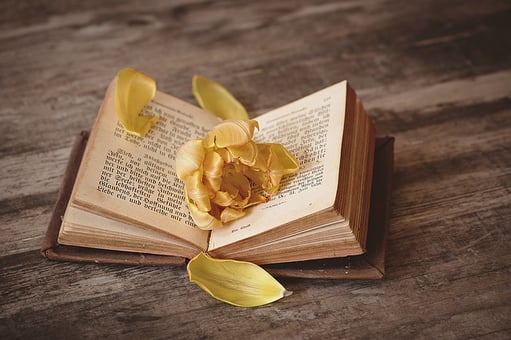
Need to write about a theme for a Great Gatsby assignment or just curious about what exactly a theme is? Not sure where to start? Learn here what a theme is, what the main themes in The Great Gatsby are, and what the best tips for writing about themes for your English/Language Arts class essays are.
We will also link to our specific articles on each theme so you can learn even more in-depth about themes central to Gatsby .
What Is a Theme? Why Should You Care?
First things first: what exactly is a theme? In literature, a theme is a central topic a book deals with. This central topic is revealed through plot events, the actions and dialogue of the characters, and even the narrator's tone. Themes can be very broad, like love, money, or death, or more specific, like people versus technology, racial discrimination, or the American Dream.
In short, a book's theme can usually answer the question, "what's the point of this book?". They're the "so what?" of literary analysis. Also, note that books can definitely have more than one major theme —in Gatsby we identify seven!
Knowing a book's major theme(s) is crucial to writing essays, since many assignments want you to connect your argument to a book's theme. For example, you might be asked to write an essay about a prompt like this: "How does the life of Jay Gatsby exemplify (or deconstruct) the idea of the American Dream?" This prompt has you connect specific details in Jay Gatsby's life to the larger theme of the American Dream. This is why many teachers love theme essays: because they encourage you to connect small details to big ideas!
Furthermore, the AP English Literature test always has an essay question that has you analyze some aspect of a book and then "compare it to the theme of the work as a whole." (If you want specific examples you can access the last 15 years of AP English Literature free response questions here , using your College Board account.) So this skill won't just help you in your English classes, it will also help you pass the AP English Literature test if you're taking it!
So keep reading to learn about the major themes in Gatsby and how they are revealed in the book, and also to get links to our in-depth articles about each theme.
Overview of Key Themes in The Great Gatsby
Before we introduce our seven main themes, we'll briefly describe how the story and characters suggest the major Great Gatsby themes. Remember that the story is set in the 1920s, a period when America's economy was booming, and takes place in New York: specifically the wealthy Long Island towns of West Egg and East Egg, as well as Manhattan and Queens.
As you should know from the book ( check out our summary if you're still hazy on the details!), The Great Gatsby tells the story of James Gatz , a poor farm boy who manages to reinvent himself as the fabulously rich Jay Gatsby, only to be killed after an attempt to win over his old love Daisy Buchanan . Daisy is married to Tom Buchanan , and they're both from old money, causing them to look down Gatsby's newly rich crowd (and for Tom to look down at Gatsby himself).
Meanwhile, Tom is having an affair with Myrtle Wilson , the wife of mechanic George Wilson . Through the Wilsons, we see the struggles of the working class in dismal Queens , NY. As if they didn't already have it hard enough, Myrtle is killed in a hit-and-run accident (caused by Daisy Buchanan), and George, who's manipulated by Tom to believe that Jay Gatsby was both his wife's lover and her murderer, ends up shooting Gatsby and then himself.
The whole story is told by Nick Carraway , a second cousin of Daisy's and classmate of Tom's who moves in next to Gatsby's mansion and eventually befriends Jay -- and then comes to deeply admire him, despite or perhaps because of Jay's fervent desire to repeat his past with Daisy. The tragic chain of events at the novel's climax, along with the fact that both the Buchanans can easily retreat from the damage they caused, causes Nick to become disillusioned with life in New York and retreat back to his hometown in the Midwest.

Aside from having a very unhappy ending, the novel might just ruin swimming pools for you as well.
The fact that the major characters come from three distinct class backgrounds (working class, newly rich, and old money) suggests that class is a major theme. But the rampant materialism and the sheer amount of money spent by Gatsby himself is a huge issue and its own theme. Related to money and class, the fact that both Gatsby and the Wilsons strive to improve their positions in American society, only to end up dead, also suggests that the American Dream -- and specifically its hollowness -- is a key theme in the book as well.
But there are other themes at play here, too. Every major character is involved in at least one romantic relationship , revealing that they are all driven by love, sex, and desire -- a major theme. Also, the rampant bad behavior (crime, cheating, and finally murder) and lack of real justice makes ethics and morality a key theme. Death also looms large over the novel's plot, alongside the threat of failure.
And finally, a strong undercurrent to all of these themes is identity itself: can James Gatz really become Jay Gatsby, or was he doomed from the start? Can someone who is not from old money ever blend in with that crowd? Could Gatsby really aspire to repeat his past with Daisy, or is that past self gone forever?
In short, just by looking at the novel's plot, characters, and ending, we can already get a strong sense of Gatsby's major themes. Let's now look at each of those themes one by one (and be sure to check out the links to our full theme breakdowns!).
The 7 Major Great Gatsby Themes
Money and Materialism : Everyone in the novel is money-obsessed, whether they were born with money (Tom, Daisy, Jordan, and Nick to a lesser extent), whether they made a fortune (Gatsby), or whether they're eager for more (Myrtle and George). So why are the characters so materialistic? How does their materialism affect their choices? Get a guide to each of the characters' material motivations and how they shape the novel.
Society and Class: Building on the money and materialism theme, the novel draws clear distinctions between the kind of money you have: old money (inherited) or new money (earned). And there is also a clear difference between the lifestyles of the wealthy, who live on Long Island and commute freely to Manhattan, and the working class people stuck in between, mired in Queens. By the end of the novel, our main characters who are not old money (Gatsby, Myrtle, and George) are all dead, while the inherited-money club is still alive. What does this say about class in Gatsby? Why is their society so rigidly classist? Learn more about the various social classes in Gatsby and how they affect the novel's outcome.
The American Dream : The American Dream is the idea anyone can make it in America (e.g. gain fame, fortune, and success) through enough hard work and determination. So is Jay Gatsby an example of the dream? Or does his involvement in crime suggest the Dream isn't actually real? And where does this leave the Wilsons, who are also eager to improve their lot in life but don't make it out of the novel alive? Finally, do the closing pages of the novel endorse the American Dream or write it off as a fantasy? Learn what the American Dream is and how the novel sometimes believes in it, and sometimes sees it as a reckless fantasy.
Love, Desire, and Relationships : All of the major characters are driven by love, desire, or both, but only Tom and Daisy's marriage lasts out of the novel's five major relationships and affairs. So is love an inherently unstable force? Or do the characters just experience it in the wrong way? Get an in-depth guide to each of Gatsby's major relationships.
Death and Failure: Nick narrates Gatsby two years after the events in question, and since he's obviously aware of the tragedy awaiting not only Gatsby but Myrtle and George as well, the novel has a sad, reflective, even mournful tone. Is the novel saying that ambition is inherently dangerous (especially in a classist society like 1920s America), or is it more concerned with the danger of Gatsby's intense desire to reclaim the past? Explore those questions here.
Morality and Ethics: The novel is full of bad behavior: lying, cheating, physical abuse, crime, and finally murder. Yet none of the characters ever answer to the law, and God is only mentioned as an exclamation, or briefly projected onto an advertisement . Does the novel push for the need to fix this lack of morality, or does it accept it as the normal state of affairs in the "wild, wild East"?
The Mutability of Identity: Mutability just means "subject to change," so this theme is about how changeable (or not!) personal identity is. Do people really change? Or are our past selves always with us? And how would this shape our desire to reclaim parts of our past? Gatsby wants to have it both ways: to change himself from James Gatz into the sophisticated, wealthy Jay Gatsby, but also to preserve his past with Daisy. Does he fail because it's impossible to change? Because it's impossible to repeat the past? Or both?
How to Write About The Great Gatsby Themes
So now that you know about the major themes of The Great Gatsby , how can you go about writing about them? First up: look closely at your prompt.
Sometimes an essay prompt will come right out and ask you to write about a theme , for example "is The American Dream in Gatsby alive or dead?" or "Write about the relationships in Gatsby. What is the novel saying about the nature of love and desire?" For those essays, you will obviously be writing about one of the novel's major themes. But even though those prompts have big-picture questions, make sure to find small supporting details to help make your argument.

For example, if you're discussing the American Dream and arguing it's dead in the novel, don't just make that claim and be done with it. Instead, you can explore Gatsby's past as James Gatz, George Wilson's exhausted complacency, and Myrtle's treatment at the hands of Tom as examples of how the American Dream is treated in the novel. Obviously those examples are far from exhaustive, but hopefully you get the idea: find smaller details to support the larger argument.
On the other hand, many essay prompts about Gatsby will look like a question about something specific, like a character or symbol:
- Explore Tom and Daisy as people who 'retreat into their money.'
- What does the green light at the end of Daisy's dock represent? How does its meaning change throughout the novel?
- Show how Fitzgerald uses clothing (and the changing of costumes) to tell the reader more about the characters and/or express theme(s).
These prompts are actually a chance for you to take that detailed analysis and connect it to one of the larger themes—in other words, even though the prompt doesn't state it explicitly, you should still be connecting those more focused topics to one of the big-picture themes.
For example, if you talk about Tom and Daisy Buchanan, you will definitely end up talking about society and class. If you talk about the green light, you will end up talking about dreams and goals, specifically the American Dream. And if you discuss clothing to talk about the characters, you will definitely touch on money and materialism, as well as society and class (like how Gatsby's pink suit makes him stand out as new money to Tom Buchanan, or how Myrtle adopts a different dress to play at being wealthy and sophisticated).
In short, for these more specific prompts, you start from the ground (small details and observations) and build up to discussing the larger themes, even if the prompt doesn't say to do so explicitly!
What's Next?
Now you're an expert on themes, but what about symbols? If you need to write about the important symbols in The Great Gatsby, check out our symbols overview for a complete guide.
Want a full analysis of Jay Gatsby and his backstory? Not sure how his story connects with the American Dream? Get the details here .
Want to go back to square one? Get started with Chapter 1 of our Great Gatsby plot summary.

Halle Edwards graduated from Stanford University with honors. In high school, she earned 99th percentile ACT scores as well as 99th percentile scores on SAT subject tests. She also took nine AP classes, earning a perfect score of 5 on seven AP tests. As a graduate of a large public high school who tackled the college admission process largely on her own, she is passionate about helping high school students from different backgrounds get the knowledge they need to be successful in the college admissions process.
Ask a Question Below
Have any questions about this article or other topics? Ask below and we'll reply!
Improve With Our Famous Guides
- For All Students
The 5 Strategies You Must Be Using to Improve 160+ SAT Points
How to Get a Perfect 1600, by a Perfect Scorer
Series: How to Get 800 on Each SAT Section:
Score 800 on SAT Math
Score 800 on SAT Reading
Score 800 on SAT Writing
Series: How to Get to 600 on Each SAT Section:
Score 600 on SAT Math
Score 600 on SAT Reading
Score 600 on SAT Writing
Free Complete Official SAT Practice Tests
What SAT Target Score Should You Be Aiming For?
15 Strategies to Improve Your SAT Essay
The 5 Strategies You Must Be Using to Improve 4+ ACT Points
How to Get a Perfect 36 ACT, by a Perfect Scorer
Series: How to Get 36 on Each ACT Section:
36 on ACT English
36 on ACT Math
36 on ACT Reading
36 on ACT Science
Series: How to Get to 24 on Each ACT Section:
24 on ACT English
24 on ACT Math
24 on ACT Reading
24 on ACT Science
What ACT target score should you be aiming for?
ACT Vocabulary You Must Know
ACT Writing: 15 Tips to Raise Your Essay Score
How to Get Into Harvard and the Ivy League
How to Get a Perfect 4.0 GPA
How to Write an Amazing College Essay
What Exactly Are Colleges Looking For?
Is the ACT easier than the SAT? A Comprehensive Guide
Should you retake your SAT or ACT?
When should you take the SAT or ACT?
Stay Informed
Get the latest articles and test prep tips!
Looking for Graduate School Test Prep?
Check out our top-rated graduate blogs here:
GRE Online Prep Blog
GMAT Online Prep Blog
TOEFL Online Prep Blog
Holly R. "I am absolutely overjoyed and cannot thank you enough for helping me!”

The Great Gatsby
F. scott fitzgerald, ask litcharts ai: the answer to your questions.

IMAGES
VIDEO
COMMENTS
The Great Gatsby 's synopsis includes the main ideas of the story told by Nick Carraway. After moving to New York, he witnesses a tragic love story of Jay Gatsby and Daisy Buchanan. The plot spins around the wealth and complicated relationship between all the characters. We will write a custom essay specifically. for you for only 11.00 9.35/page.
The Great Gatsby is F. Scott Fitzgerald's third novel. It was published in 1925. Set in Jazz Age New York, it tells the story of Jay Gatsby, a self-made millionaire, and his pursuit of Daisy Buchanan, a wealthy young woman whom he loved in his youth. Commercially unsuccessful upon publication, the book is now considered a classic of American fiction.
The Great Gatsby is the quintessential Jazz Age novel, capturing a mood and a moment in American history in the 1920s, after the end of the First World War. Rather surprisingly, The Great Gatsby sold no more than 25,000 copies in F. Scott Fitzgerald's lifetime. It has now sold over 25 million copies. If Fitzgerald had stuck with one of the ...
In East Egg, the next town over, where old money people live, Nick reconnects with his cousin Daisy Buchanan, her husband Tom, and meets their friend Jordan Baker. Tom takes Nick to meet his mistress, Myrtle Wilson. Myrtle is married to George Wilson, who runs a gas station in a gross and dirty neighborhood in Queens.
Short Summary of The Great Gatsby Plot. The story is narrated by Nick Carraway, who is 30 years old and comes from a wealthy family. Chapter 1 tells us how he starts his business in credit dealings after returning from the war. He rented a house in West Egg across the bay from the house of his second cousin Daisy.
The Great Gatsby Summary. In the summer of 1922, Nick Carraway moves from Minnesota to work as a bond salesman in New York. Nick rents a house in West Egg, a suburb of New York on Long Island full of the "new rich" who have made their fortunes too recently to have built strong social connections. Nick graduated from Yale and has connections in ...
Yale graduate Nick Caraway returns from World War I and becomes a bond salesman, moving to a Long Island suburb called West Egg and renting a small house beside a mansion owned by a man named Jay Gatsby. West Egg is full of newly rich people, but East Egg—across the bay—is where the "old rich" live. After dinner with his cousin Daisy in ...
Tom is a former football player, a brutal bully obsessed with the preservation of class boundaries. Daisy, by contrast, is an almost ghostlike young woman who affects an air of sophisticated boredom. At the Buchanans's, Nick meets Jordan Baker, a beautiful young woman with a cold, cynical manner.
Excellent. 2 pages / 990 words. Prompt Examples for "The Great Gatsby" Essay Character Analysis: Analyze the character of Pammy Buchanan in The Great Gatsby, exploring her role in the narrative and how her presence reflects aspects of her parents, Tom and Daisy. Symbolism and Themes: Discuss the symbolism of Pammy...
The Great Gatsby is a fiction novel published in 1925 by the American author F. Scott Fitzgerald.Inspired on Fitzgerald's own experiences during the Jazz Age of the 1920s, The Great Gatsby captures the prosperity and the hedonism of the era through a cast of characters who reside in the fictional Long Island towns of West Egg and East Egg.Despite a cold reaction from critics and audiences ...
The publication of his first novel, This Side of Paradise, in 1920, made Fitzgerald a literary star. He married Zelda one week later. In 1924, the couple moved to Paris, where Fitzgerald began work on The Great Gatsby. Though now considered his masterpiece, the novel sold only modestly. The Fitzgeralds returned to the United States in 1927.
The Great Gatsby, novel by American author F. Scott Fitzgerald, published in 1925. It tells the story of Jay Gatsby, a self-made millionaire, and his pursuit of Daisy Buchanan, a wealthy young woman whom he loved in his youth. Set in 1920s New York, the book is narrated by Nick Carraway. After moving to the fictional West Egg on Long Island ...
Related to money and class, the fact that both Gatsby and the Wilsons strive to improve their positions in American society, only to end up dead, also suggests that the American Dream -- and specifically its hollowness -- is a key theme in the book as well. But there are other themes at play here, too.
Hypocrisy and rot are at the heart of old money in the 1920s boom. Upon returning from dinner, Nick sees Jay Gatsby standing on his lawn and gazing out across Long Island sound. Nick considers calling out to Gatsby, but stops himself when he sees Gatsby extend his arms out toward the far side of the water.
Romantics relate to Gatsby's unrelenting commitment to Daisy, the love of his life. But beneath all the decadence and romance, The Great Gatsby is a severe criticism of American upper class ...